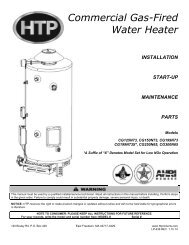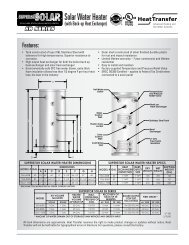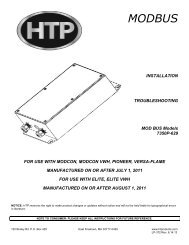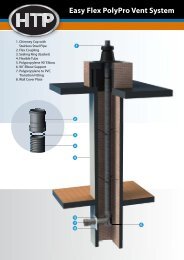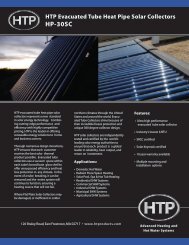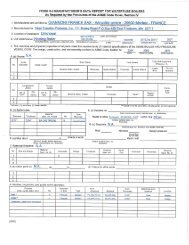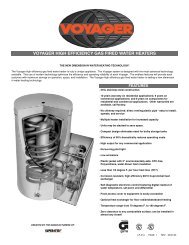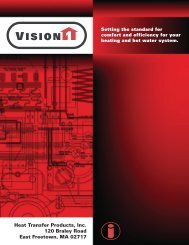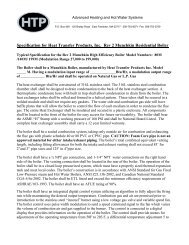MC Series Gas-Fired Circulating Heater - Heat Transfer Products, Inc
MC Series Gas-Fired Circulating Heater - Heat Transfer Products, Inc
MC Series Gas-Fired Circulating Heater - Heat Transfer Products, Inc
Create successful ePaper yourself
Turn your PDF publications into a flip-book with our unique Google optimized e-Paper software.
H. EXHAUST VENT AND INTAKE PIPE INSTALLATION<br />
1. The 2” exhaust vent connection is located on the top, right side of the unit, and the intake is on the top left side. Use only solid PVC<br />
or CPVC pipe, AL29-4C Stainless Steel, or a Polypropylene vent system approved for use with Category IV appliances. FOAM CORE<br />
PIPING IS NOT APPROVED.<br />
46<br />
All joints of positive pressure vent systems must be sealed completely to prevent leakage of flue products into living space.<br />
2. Remove all burrs and debris from joints and fittings.<br />
3. When using PVC or CPVC pipe, all joints must be properly cleaned, primed, and cemented. Use only cement and primer approved<br />
for use with the pipe material. Cement must conform to ASTM D2564 for PVC and ASTM F493 for CPVC pipe. NOTE: DO NOT<br />
CEMENT POLYPROPYLENE PIPE.<br />
4. Ensure the vent is located where it will not be exposed to prevailing winds.<br />
5. In all roof venting applications, exhaust discharge must point away from the pitch of the roof.<br />
6. To prevent water leakage, install adequate roof flashing where the pipe enters the roof.<br />
7. Do not locate vent over public walkways, driveways, or parking lots. Condensate could drip and freeze, resulting in a slip hazard or<br />
damage to vehicles and machinery.<br />
8. Due to potential moisture build-up, sidewall venting may not be the preferred venting option. To save time and cost, carefully<br />
consider venting installation and location.<br />
9. Horizontal lengths of exhaust vent must slope back towards the heater not less than ¼" per foot to allow condensate to drain from<br />
the vent pipe.<br />
10. The exhaust vent must terminate where vapors cannot make accidental contact with people or pets, or damage shrubs or plants.<br />
11. In vacant chimney applications, install and seal a rain cap over existing chimney openings.<br />
12. All piping must be fully supported. Use pipe hangers at a minimum of 4 foot intervals to prevent sagging of the pipe where<br />
condensate may form.<br />
13. Do not use the heater to support any piping.<br />
14. A screened straight coupling is provided with the heater for use as an outside exhaust termination.<br />
15. A screened inlet air tee is provided with the heater to be used as an outside intake termination.<br />
The following information on Table 7 lists optional intake air/exhaust vent terminations available from HTP.<br />
Table 7<br />
DESCRIPTION<br />
STOCK CODE<br />
2” PVC CONCENTRIC VENT TERMINATION KIT KGAVT0501CVT<br />
3” PVC CONCENTRIC VENT TERMINATION KIT KGAVT0601CVT<br />
2” STAINLESS STEEL VENT TERMINATION KIT V500<br />
3” STAINLESS STEEL VENT TERMINATION KIT V1000<br />
4” STAINLESS STEEL VENT TERMINATION KIT V2000<br />
3” POLYPRO VENT KIT 8400P-001<br />
LP-171 Rev. 10.2.13



